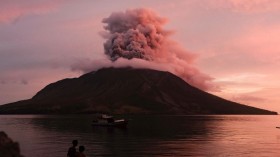Last year, sun-watching spacecraft spotted a series of unusually slow eruptions on the surface of the Sun that the space agency has described as almost "reluctant." Now researchers have determined some of the factors that can cause such a slow eruption to occur.
According to NASA, the eruptions, called coronal mass ejections (CME) occurred over three days starting on Jan. 17, 2013, and were first noticed by the joint European Space Agency (ESA) and NASA's Solar and Heliospherioc Observatory (SOHO).
The SOHO, one of several unmanned orbital crafts with their "eyes" on the Sun, observed puffs of plasma and radiation emanating from the base of the corona - the star's outmost atmosphere.
"The puffs occurred roughly once every three hours. After about 12 hours, a much larger eruption of material began, apparently eased out by the smaller-scale explosions," NASA reported.
Most CMEs are more abrupt and violent, and do not take long to build up. NASA's Interface Region Imaging Spectrograph (IRIS) recently caught a more common and faster CME in action last May, and can be viewed here.
Combined with frequency-specific imagery take by NASA's Solar Dynamics Observatory (SDO) and Solar Terrestrial Relations Obersvatory (STRO), the SOHO data helped solar scientist Nathalia Alzate and her team determine the cause of the slow January CME event.
"Looking at the corona in extreme ultraviolet light we see the source of the puffs is a series of energetic jets and related flares," said Alzate. "The jets are localized, catastrophic releases of energy that spew material out from the sun into space. These rapid changes in the magnetic field cause flares, which release a huge amount of energy in a very short time in the form of super-heated plasma, high-energy radiation and radio bursts. The big, slow structure is reluctant to erupt, and does not begin to smoothly propagate outwards until several jets have occurred."
According to Alzate, the speed of their event may be dependent on things like shock waves from flares or magnetic reconfiguration. With new observational crafts like the ISIS however, she believes that her team's theories will be verified in the near-future.
"Thanks to recent advances in observation and in image processing techniques we can throw light on the way jets can lead to small and fast, or large and slow, eruptions from the sun," she said.
Alzate presented her findings on what caused the puffs at the 2014 Royal Astronomical Society's National Astronomy Meeting in Portsmouth, England.
As these results have not yet been published it a peer-reviewed journal, it is recommended that they be viewed as preliminary findings.
© 2024 NatureWorldNews.com All rights reserved. Do not reproduce without permission.




